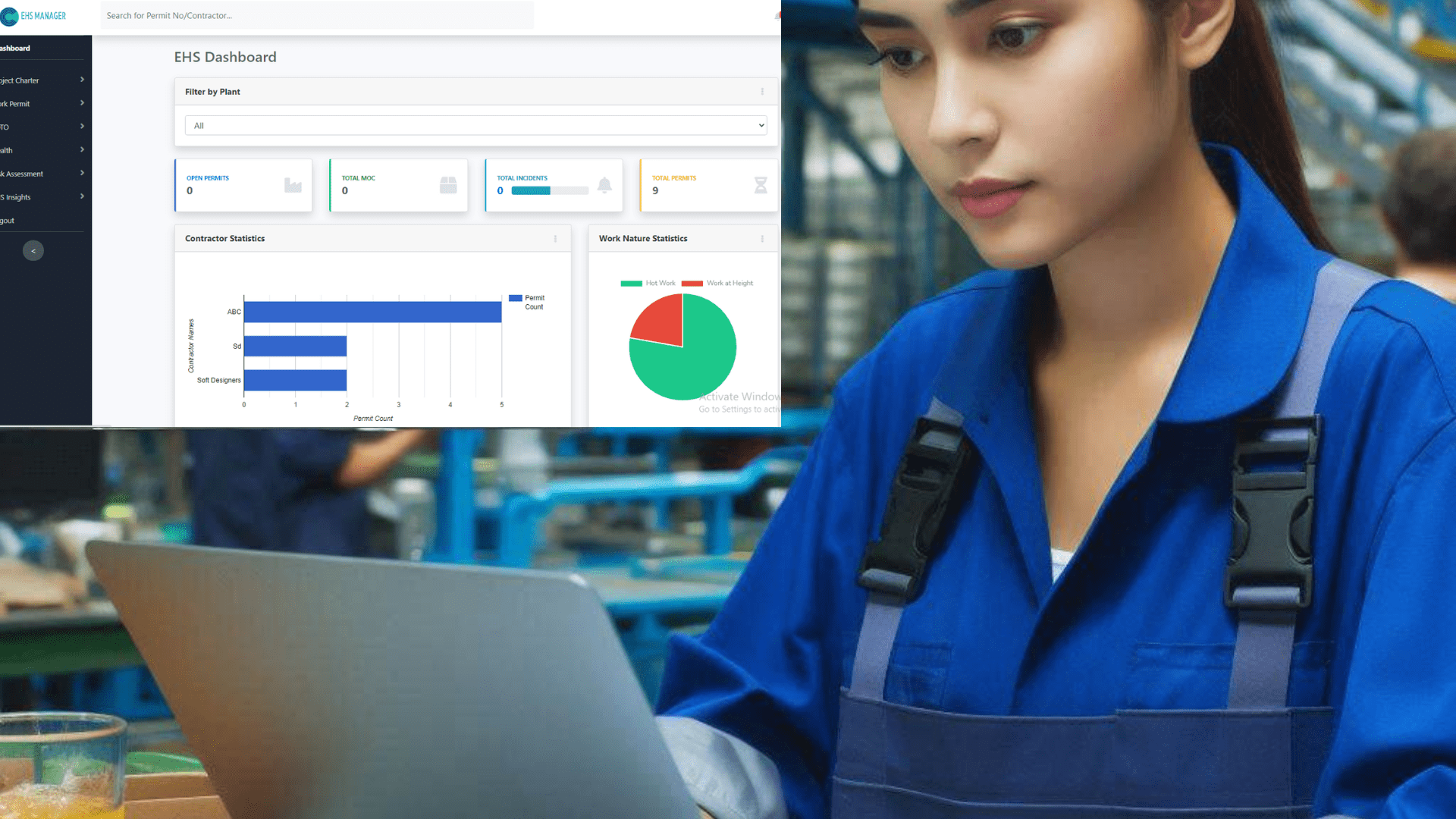From Spreadsheet to AI: The Evolution of EHS Data Analytics
Introduction
The Environmental, Health, and Safety (EHS) data analytics is undergoing a technological revolution. For decades, spreadsheets like Microsoft Excel were the industry standard for tracking incidents, audits, training, and compliance metrics. However, as industrial operations become more complex and data-intensive, traditional methods fall short in accuracy, efficiency, and scalability. Today, organizations are moving toward AI-driven EHS platforms that harness real-time data, predictive analytics, and automation to transform how safety is managed.
The Limitations of Spreadsheets in EHS Management
Spreadsheets offer a familiar and low-cost solution, they come with major limitations:
- Data Accuracy and Validation: Manual data entry introduces errors and inconsistencies, compromising the reliability of safety reports and compliance documentation.
- Time Consumption: EHS professionals spend up to 50% of their time collecting, organizing, and analyzing data manually.
- Manual Follow-ups: Incident investigations, action tracking, and obtaining physical signatures for approvals slow down the safety process.
- Poor Collaboration: Teams using spreadsheets often face difficulties in knowledge transfer and standardization.
- Lack of Scalability: As operations grow, managing thousands of rows of data across departments becomes unmanageable.

Smarter Safety: How Emerging Technologies Are Transforming EHS Analytic
a) AI is Revolutionizing EHS Data Analytics
The adoption of AI and machine learning is transforming EHS data analytics. Some key benefits include:
- Real-time Alerts and Views : Instant notifications and dashboards enable proactive decision-making.
- Automated Data Collection : By automating data collection, organizations can minimize errors and allocate resources more efficiently.
- Action Tracking : Efficient tracking of actions, investigations, and reports.
- Standardized Methods : Consistent approaches to data analysis and reporting.
- Identifying Trends : AI-powered insights reveal significant patterns and trends.
- Predictive Analytics : Predictive modeling enables organizations to anticipate and prevent incidents.

b) IoT Integration and Environmental Monitoring
The Internet of Things (IoT) is also playing a crucial role in EHS data analytics. IoT sensors can monitor:

- Poisonous Gases : Real-time monitoring of gas emissions and consumption.
- Water Quality : Continuous monitoring of water quality and detection of pollutants.
- Air Quality Monitoring : Tracking air quality and identifying pollutants to ensure a safe environment.
Check out these IoT sensor options:
https://www.vighnaharta.in/gas-detection/industrial.html
https://www.bannerengineering.com/in/en/products/sensors/temperature-sensors.html
c) Augmented Reality in Safety Analytics and Training
AR technology is being used to create immersive analytics experiences, enabling users to visualize complex data in new and innovative ways. AR analytics can:
- Enhance Data Visualization : Interactive and immersive visuals that bring data to life, facilitating better insights and decision-making.
- Improve Training : AR-based training programs for employees.
d) Digital Signatures: The Smarter Alternative to Physical Approvals
Physical signatures can lead to delays and complications. They often require manual handling and can be prone to errors. This traditional method can also limit flexibility and slow down business operations.
Limitations of Physical Signature Approvals.
- Time-consuming : Obtaining physical signatures can delay decision-making and action-taking.
- Logistical challenges : Physical signatures require in-person meetings or mailing documents.
- Security risks : Physical documents can be lost, stolen, or tampered with.
Benefits of Digital Signature Approvals
- Increased efficiency : Digital signatures enable faster approvals and decision-making.
- Improved security : Digital signatures offer robust security and detailed audit trails, ensuring data integrity.
- Enhanced collaboration : Digital signatures facilitate collaboration and approval processes across distributed teams.
e) OSHA Compliance: Smarter, Safer, Simpler
Companies that prioritize OSHA compliance create safer workplaces and minimize financial risks. This proactive approach leads to fewer workplace accidents, better employee health, and improved operational efficiency.
Challenges with Spreadsheets
- Data accuracy : Manual data entry in spreadsheets can lead to errors, which may compromise the accuracy of the data.
- Compliance risks : Spreadsheets may not meet OSHA record-keeping requirements.
- Limited scalability : As data volumes increase, spreadsheets often become increasingly Unmanageable and hard to manage.
AI-Powered OSHA Compliance Solutions
- Automated record-keeping : AI-powered solutions can automate OSHA record-keeping, reducing errors and improving accuracy.
- Incident tracking : AI-powered solutions can track incidents, injuries, and illnesses, enabling proactive decision-making.
- Compliance reporting : AI-powered solutions can generate compliance reports, reducing administrative burdens.
f) Effective Knowledge Transfer and Retention
Knowledge transfer in EHS involves sharing expertise, best practices, and lessons learned to ensure continuity and preserve valuable knowledge within the organization. In the context of EHS, knowledge transfer can involve:
Challenges of Knowledge Transfer
- Knowledge retention : When employees depart, valuable knowledge and expertise can be lost, posing a significant risk to organizational continuity.
- Knowledge sharing : Encouraging employees to share knowledge can be challenging.
- Documentation : Documenting knowledge and procedures can be time-consuming.
Solutions for Effective Knowledge Transfer
- Digital platforms : Using digital platforms, such as knowledge management systems, can facilitate knowledge transfer.
- Training programs : Developing formal training programs can ensure knowledge is transferred to employees.
- Mentorship programs : Establishing mentorship programs can pair experienced employees with new employees, facilitating knowledge transfer.
g) Root Cause Analysis (RCA) with AI/ML
- Predictive analytics : AI/ML can identify potential root causes and predict future incidents.
- Pattern recognition : AI and machine learning algorithms can identify complex patterns in data, revealing insights into underlying causes and trends.
- Automated analysis : AI/ML can automate the analysis of large datasets, reducing manual effort.
Use Cases in Manufacturing and Industrial Safety
- Predictive Maintenance : Utilize machine learning algorithms to forecast potential equipment failures, enabling proactive maintenance and minimizing unexpected downtime. This approach helps organizations optimize resource allocation, reduce costs, and ensure operational efficiency.
- Automated OSHA Record-Keeping : Implement AI-powered solutions to automate OSHA record-keeping and reduce errors.
- Real-Time Environmental Monitoring : Utilize IoT sensors to monitor air and water quality, detecting pollutants and ensuring compliance.
- Incident Investigation : Apply AI-driven analytics to identify underlying causes of incidents, enabling data-informed decision-making and targeted corrective actions.
- Knowledge Transfer : Implement digital platforms and training programs to Improve knowledge transfer and preserve valuable expertise.
- Predictive Analytics : Use AI to identify potential safety risks before they happen, helping prevent accidents.
- Automated Compliance Reporting : Implement AI-powered solutions to generate compliance reports, reducing administrative Workload.
- AR-Based Training : Develop immersive training programs using AR technology to enhance employee engagement and knowledge retention.
Conclusion
The Evolution of EHS data analytics from traditional spreadsheets to AI-driven solutions has revolutionized the way organizations approach environmental, health, and safety management. By Applying AI, IoT, and AR technologies, organizations can improve data accuracy, enhance collaboration, and make informed decisions. As the industry continues to adopt digital solutions, it’s clear that AI-powered EHS data analytics will play a critical role in shaping the future of workplace safety and sustainability.























